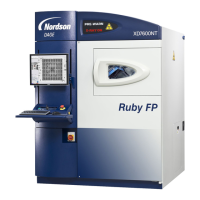ADJUSTING THE SETTINGS FOR BEST IMAGE
There are several machine adjustments that contribute to the final image.
Note : Anytime you want to refresh the image just left click on it..
a) Tube voltage
Start at the lowest voltage and look for the x-ray penetration through the darkest (thickest) part of the
sample. If there is insufficient penetration, then increase the voltage.
b) Tube power
Increase the power as far as possible whilst ensuring that no part of the image is saturated.
Noise reduction
Noise in the image is an inherent part of X-ray imaging due to the nature of the x-rays and the imaging
devices used. Noise in a picture is often made worse by image enhancement because defects, like noise
are often very slight changes in intensity, and the system cannot distinguish between them in the picture.
c) Image averaging
A live picture from the image intensifier is usually noisy, but this can be substantially reduced by
averaging over a number of picture frames. Higher numbers give smoother images, but require more
time. Typically, 32 pictures are averaged. However, when working on very low contrast images, maybe at
high magnification, averages can be made of up to 1024 pictures.
Note: The system will always wait until the average image is made before applying any image
enhancements. If an average of 128 pictures or greater is selected you will have to wait till the progress
indicator turns green.
d) Enhancing the contrast
Most images will look better when the brightness and contrast are adjusted. “Contrast stretching” is one
of the most useful tools for revealing part defects. Press the <Stretch Contrast> button
Use the sliders on the left of the screen.
Adjust the white level to enhance darker tones and lose light detail.
Adjust the black level to enhance lighter tones and lose dark detail.
Adjust the 50% gray level (gamma) to enhance lighter or darker tones without losing detail

